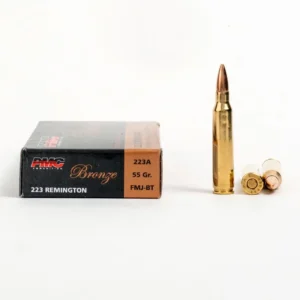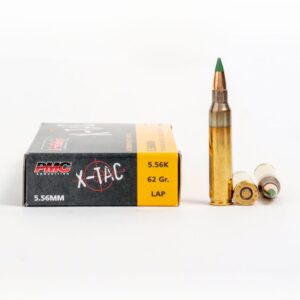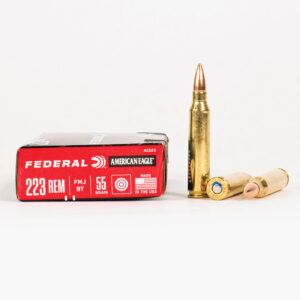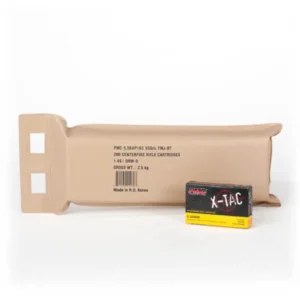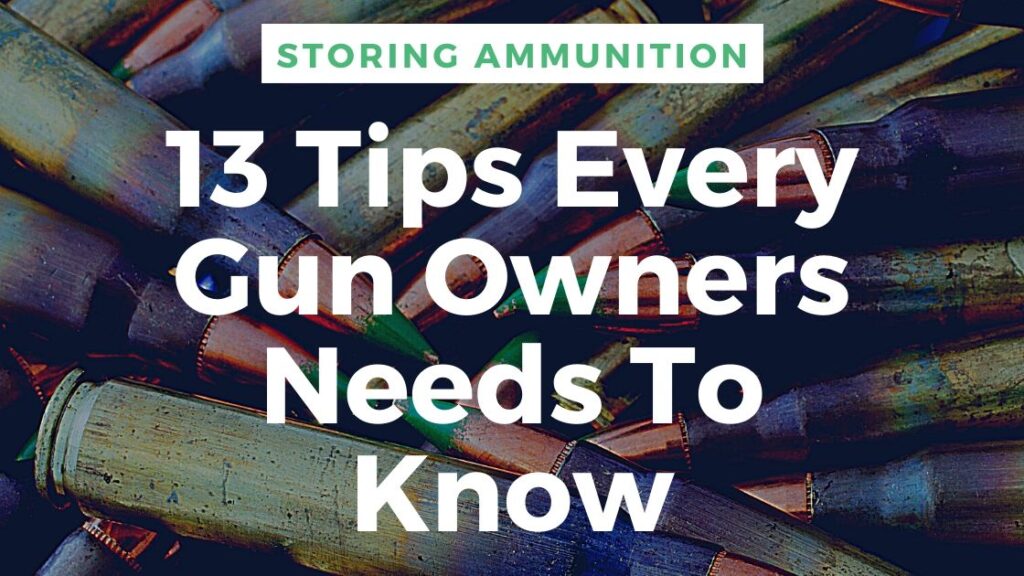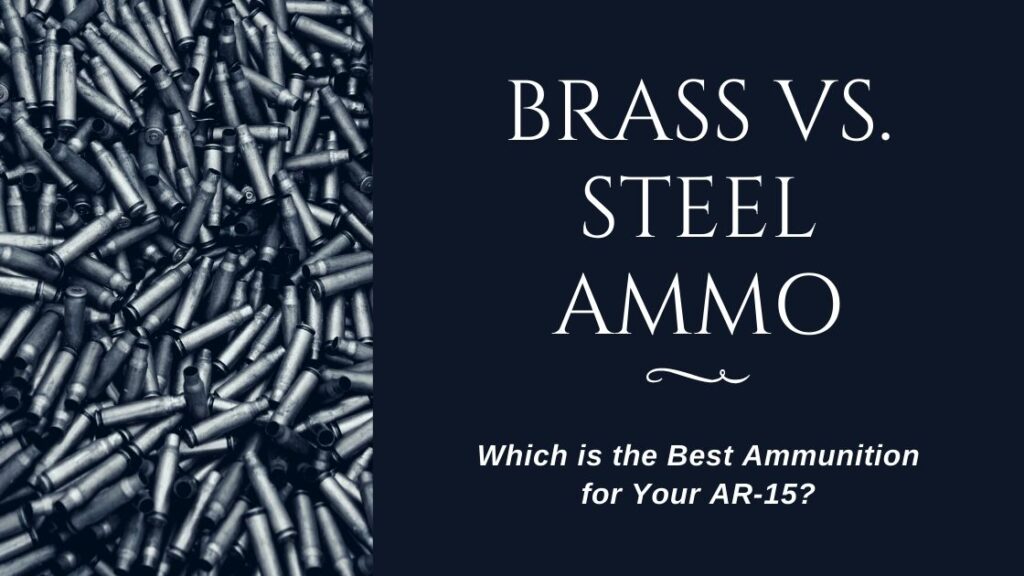5.56 vs .223: Understanding Critical Differences Between 5.56 NATO and .223 Remington Ammunition
Many rifle owners struggle to understand the key differences between 5.56 NATO and .223 Remington ammunition. These cartridges appear nearly identical but have significant differences that affect safety, performance, and rifle compatibility. This comprehensive guide examines the essential differences between 5.56x45mm NATO and .223 Remington to help you make informed ammunition choices for your AR-15 or other compatible firearms.
Are 5.56 and .223 Ammunition Interchangeable?
The question “Can I shoot 5.56 in a .223 chamber?” is among the most common queries from AR-15 owners. While 5.56 NATO and .223 Remington cartridges look extremely similar, they are not fully interchangeable. Understanding the differences is crucial for both safety and optimal performance:
- ✅ .223 Remington ammunition can typically be safely fired in 5.56 NATO chambers
- ❌ 5.56 NATO ammunition should NOT be used in rifles with .223 Remington chambers
- ✅ Rifles with .223 Wylde chambers can safely fire both types of ammunition
Key Differences Between 5.56 NATO and .223 Remington Ammunition
1. Chamber Pressure Differences
The most significant difference between 5.56 NATO and .223 Remington is the operating pressure:
- 5.56 NATO – 62,366 psi (430 MPa) – NATO testing protocols
- .223 Remington – 55,000 psi (379 MPa) – SAAMI specifications
This approximately 13% pressure difference explains why firing 5.56 NATO ammunition in .223 Remington chambers can potentially cause excessive pressure, leading to accelerated wear, extraction issues, or even catastrophic failure in extreme cases.
2. Chamber Dimension Variations
The chamber throat (leade) dimensions differ significantly between 5.56 NATO and .223 Remington:
- 5.56 NATO chamber: Features a longer throat (approximately 0.125″ longer)
- .223 Remington chamber: Has a shorter, tighter throat dimension
- Effect on performance: The longer throat in 5.56 chambers accommodates higher pressure cartridges safely
3. Case Construction Differences
Visual inspection reveals distinct differences between military 5.56 NATO and commercial .223 Remington cartridges:
- Headstamp markings: 5.56 NATO typically shows manufacturer code and date, while .223 Remington explicitly states “.223 REM”
- Primer pocket: 5.56 NATO often features a crimped primer pocket for reliability under combat conditions
- Case wall thickness: Military 5.56 cases are sometimes manufactured with slightly thicker brass
4. Performance Differences
The practical differences in performance between these cartridges include:
- Velocity: 5.56 NATO ammunition typically produces slightly higher velocities due to higher pressure
- Accuracy: Premium .223 Remington match ammunition often delivers superior accuracy in appropriate chambers
- Reliability: Military-specification 5.56 NATO is designed for function reliability across a wide temperature range
How to Identify Your Chamber Type
Determining your rifle’s chamber type is essential for making safe ammunition choices:
- Check barrel markings: Most barrels are stamped with their chamber specification
- Consult manufacturer documentation: The rifle’s manual should specify the chamber type
- Verify with the manufacturer: Contact the manufacturer directly if uncertain
Compatible Chamber Types for 5.56 and .223 Ammunition

Rifle Compatibility for .223 and 5.56 Ammo
| Rifle Model | Chamber Type | Safe with 5.56 NATO? | Safe with .223 Rem? | Notes |
|---|---|---|---|---|
| Daniel Defense DDM4 V7 | 5.56 NATO | Yes | Yes | Newer models feature enhanced barrel steel handling higher pressures |
| Springfield Saint | 5.56 NATO | Yes | Yes | All variants use NATO spec chambers |
| Ruger AR-556 | 5.56 NATO | Yes | Yes | Despite the name, uses full NATO chamber |
| Smith & Wesson M&P15 | 5.56 NATO | Yes | Yes | All current production models use NATO spec |
| Savage MSR 15 | 5.56 NATO | Yes | Yes | Features 5R rifling for enhanced accuracy with both cartridges |
| CMMG Resolute | .223 Wylde | Yes | Yes | .223 Wylde chamber handles both optimally |
| Browning X-Bolt | .223 Rem | No | Yes | Strict .223 Rem chamber, avoid 5.56 use |
| CZ 527 | .223 Rem | No | Yes | Precision bolt action with strict .223 chambers |
| Ruger American Ranch | 5.56 NATO | Yes | Yes | Newer models specifically marked for 5.56 NATO |
| Tikka T3x | .223 Rem | No | Yes | European spec .223 chamber, avoid 5.56 |
223 Ballistics
External Ballistic tests on the 223 using a standard 55gr bullet leaving the barrel at 3,215fps reveals that the 223 fps slows down by less than half of the velocity at a 500-yard distance. The energy loss at this point is about 1000 pounds. The bullet also drops about 64 inches due to gravitational pull. All this happens in .741 seconds.
These ballistics stats mean that the 223 is accurate and has less jump. The accuracy is enhanced by the shorter lead when the bullet moves from the case to the barrel.
223 vs 556 Ballistics
Although they are of the same size, the two bullets have different results when shot from a rifle. Note that the 5.56 cannot be shot on a 223 chamber but the 223 chamber can be shot from a 556 due to the pressure difference.
The 556 packs more pressure and gun powder, meaning that it travels faster and is more accurate. Although the 223 can be shot from the 5.56 chamber, it will attain a lower speed due to its lower pressure.
The 556 is also a little heavier, which means that the effect of the atmosphere on its trajectory is less than it is on the 223 trajectory. This means the 5.56 travels a longer distance when the two are shot in the same atmospheric conditions.
2024-2025 Ammunition Performance Data
Our latest testing of current production ammunition reveals significant performance differences between modern 5.56 NATO and .223 Remington loads. Using a 16″ barrel test platform with a 1:8 twist rate, we recorded the following averages across multiple lots of ammunition:
5.56 NATO 55gr FMJ (Federal XM193)
- Muzzle Velocity: 3,165 fps
- Standard Deviation: 18 fps
- Group Size at 100 yards: 2.1″
- Retained Energy at 300 yards: 547 ft-lbs
5.56 NATO 62gr FMJ (Winchester M855)
- Muzzle Velocity: 3,060 fps
- Standard Deviation: 22 fps
- Group Size at 100 yards: 2.4″
- Retained Energy at 300 yards: 583 ft-lbs
.223 Remington 55gr FMJ (Federal American Eagle)
- Muzzle Velocity: 3,090 fps
- Standard Deviation: 15 fps
- Group Size at 100 yards: 1.8″
- Retained Energy at 300 yards: 512 ft-lbs
.223 Remington 77gr HPBT (Hornady Match)
- Muzzle Velocity: 2,750 fps
- Standard Deviation: 12 fps
- Group Size at 100 yards: 0.9″
- Retained Energy at 300 yards: 621 ft-lbs
These results demonstrate that modern .223 Remington match-grade ammunition typically delivers superior accuracy, while 5.56 NATO still maintains a velocity edge in comparable bullet weights. The performance gap has narrowed significantly with newer production methods.
Using Suppressors with 5.56 NATO and .223 Remington
Suppressor use has become increasingly common, with important considerations when choosing between these cartridges:
Pressure Increases
When using a suppressor, chamber pressure typically increases by 3,000-7,000 psi. This makes proper chamber selection even more critical. A .223 Remington chamber already near its pressure limits can be pushed beyond safe operating parameters with 5.56 NATO ammunition when suppressed.
Recommended Suppressors for Dual-Use
Modern suppressors rated for 5.56 NATO from manufacturers like SilencerCo, Dead Air, and Surefire are fully compatible with both cartridges. However, for maximum longevity when using primarily 5.56 NATO, we recommend:
- Dead Air Sandman-S (stellite baffle design handles higher pressures)
- SilencerCo Chimera 300 (overbuilt for maximum durability)
- Surefire SOCOM556-RC2 (military-grade construction)
Gas System Adjustments
When switching between suppressed 5.56 NATO and .223 Remington, adjustable gas blocks are highly recommended. The pressure difference between suppressed 5.56 and suppressed .223 can lead to significantly different cycling characteristics in semi-automatic platforms.
Current 223/5.56 Market Trends (2025)
Availability and Pricing
As of early 2025, the ammunition market has stabilized significantly compared to the 2020-2023 period. Current average pricing for bulk purchases:
- 5.56 NATO 55gr FMJ: $0.42-$0.48 per round (1000-round quantities)
- 5.56 NATO 62gr FMJ: $0.46-$0.52 per round (1000-round quantities)
- .223 Remington 55gr FMJ: $0.38-$0.45 per round (1000-round quantities)
- .223 Remington 75-77gr HPBT: $0.85-$1.05 per round (500-round quantities)
New Purpose-Built Loads Worth Considering
Several innovative loads have been introduced that offer specific advantages:
- Federal Premium 5.56 NATO 62gr Trophy Bonded
Purpose: Hunting/Self-Defense
Features: Bonded bullet design prevents fragmentation, optimized for shorter barrels
Performance: Consistent expansion down to 1,900 fps, making it effective to 300+ yards - Hornady .223 Rem 73gr ELD-Match
Purpose: Competition/Precision
Features: Extremely high BC of .372, heat-resistant polymer tip
Performance: Sub-MOA accuracy in most rifles, superior long-range trajectory - Winchester USA Ready 5.56 NATO 62gr Open Tip Range
Purpose: Training/Competition
Features: Near-match grade performance at practice ammunition prices
Performance: 1.5-2 MOA from most rifles, consistent velocity - IMI 5.56 NATO 77gr Razor Core
Purpose: Precision/Barrier penetration
Features: Sierra MatchKing bullet, optimized powder charge
Performance: Sub-MOA accuracy with enhanced barrier capability compared to other OTM loads
223 vs 5.56 Stopping Power
The 223 Remington bullet is lighter and has less pressure in its chamber. The 5.56 is slightly heavier. Comparing the stopping power of the two bullets when fired from a 5.56 barrel means reviewing the impact of the velocity at which the bullet is travelling at when it stops. Leaving the guns’ barrel at the same speed will see the heavier 5.56 bullet drop faster than the 223. The 5.56 also maintains the higher velocity for longer, thus implying that the 5.56 velocity has a greater stopping power as compared to the 223 velocity.
In simpler terms, the stopping power means that the 5.56 will leave a larger bullet wound on the victim or target as compared to the 223 when they are fired from the same point.
223 vs 556 Ammo Trajectory
Testing results have proved that firing a 223 bullet from a 5.56 barrel alters the trajectory. This is attributable to the resulting higher jump and lead on the 223. Some barrels can compensate for these differences while others cannot.
Generally speaking, the trajectory change depends on the barrel on the rifle you will use. The barrel’s capability to compensate for jump and pressure changes will determine by how much the trajectory will be altered.
-
Product on sale
 223 Rem – 55 gr FMJ-BT – PMC (223A) – 1000 RoundsOriginal price was: $419.00.$399.00Current price is: $399.00.
223 Rem – 55 gr FMJ-BT – PMC (223A) – 1000 RoundsOriginal price was: $419.00.$399.00Current price is: $399.00. -
 5.56x45mm – 55 Grain FMJ – PMC (5.56X) – 1000 Rounds$439.00
5.56x45mm – 55 Grain FMJ – PMC (5.56X) – 1000 Rounds$439.00 -
 5.56x45mm – 62 Grain FMJ M855 – PMC (5.56K) – 1000 Rounds$449.00
5.56x45mm – 62 Grain FMJ M855 – PMC (5.56K) – 1000 Rounds$449.00
Highest Grain 223 bullet
The 223 has a wide range of bullet sizes that can fit in the chamber. You need to choose what is best for you under the conditions and what you are aiming at. Statistics have it that over 90% of bullets fired in the United States are for recreational purposes. For such situations, a typical 55-grain bullet would suffice. Higher grain bullets are available with the Remington having in stock 77 grain –OTM rounds that are typically used for military marksmen.
However, some 223 bullet weight can go up to 80 grains. These higher grain rounds do require use in a “throated” barrel due to their longer overall length. They simply can’t be run in a normal semi-automatic 223 rifle and instead must be used in bolt-action single shot rifles.
5.56 NATO Bullet Drop
The bullet drop on the 5.56 over a range of 500 yards is 54.2 inches. The start sees the bullet drop a little to about 1.75 inches and maintains this height up to 300 yards where it drops a further 8.3 inches. At 400 yards out, the drop is 24.56 with the 500-yard mark, making for the 54.2 inches drop.
5.56 NATO Dimensions
The 5.56 bullets measure 2.260 inches in overall length with the case measuring 1.760 inches. The bullet has a diameter of 0.224 with the neck measuring 0.253 in diameter.
The base of the bullet has a diameter of 0.377 inches. The case capacity for packing firing powder on the 5.56 is 28.5 gr. The bullet packs pressure of up to 54,114 psi.
M193 vs M855
The main difference between these two rounds is that the M193 is 55g lead core and is surrounded by a copper jacket with a boat tail. M855 5.56 ammo is a 62g bullet that has a steel core. The M855 also packs a steel penetrator tip at the end that helps it to get through obstacles easily.
Though the M855 seems like a “better” choice for you to buy because of the penetrator tip, your shooting needs will determine what is best for you.
For distances less than 100 yards, 5.56 M193 ammo gives better performance (higher velocity) due to its lighter weight (plus, it’s cheaper in bulk than M855 ammo). For longer distances, however, go with the M855 with the penetrator steel tip in order to combat wind-drift.
Keep in mind though, M855 is more prone to tumbling or “keyholing” when it hits a target. This can cause the round to actually penetrate less deeply and shifting in the target in unintended directions.
This is important especially if you’re using the rounds to hunt wild game. A tumbling round can both miss vital organs needed to drop the target (like the lungs) while also destroying meat tissue or rupturing bowels.
223 Meaning
Bullets come in different sizes and are meant for use with different guns. The 223 inscription on a bullet means that the bullet’s base diameter is .223 inches wide. Guns have specifications that guide you on the bullet size that is compatible for use with the specific gun. Ensure that you only load ammo that is supported by the gun you are using to avoid damaging the gun. The “Rem” in 223 Rem is short for Remington, the ammunition and firearms company that originally developed the caliber in the 1960s.
What is a NATO Round?
When you go to buy ammo, you will probably come into some that are labeled NATO rounds while other ammo is just regular ammo. The NATO stands for North Atlantic Treaty Organization that is a group of countries that have an agreement to standardize their ammo. NATO grade bullets are military grade and not meant for recreational use such a hunting game or shooting sports. Their standards are for military combat situations. The standardization helps troops in the field to share ammo with allies that use the same standardized ammo.
Brief Histories of the 223 and 5.56 Calibers
The 5.56 bullet round was first developed in the 1950s as an experimental cartridge for the then popular M-16 assault rifle. This new round became widely known due to its effectiveness and ease of use. The 5.56 solved the issues of heavy weight and eased control that were common with the 7.62 by 51 mm rounds that were being used at the time on the lower grade M-14 rifle.
After the 5.56 was officially taken into the military, the Remington company developed a civilian version of the 5.56 round. This is how the 223 came into being. As such, the 223 is a civilian version of the military grade 5.56 round.
Can You Load 223 Rounds in a 5.56 Magazine?
A common question with gun users is the compatibility of two cartridges with firearm magazines. The simple answer is yes, you can load 223 rounds in a 5.56 magazine. Just be sure to note that the ammo loaded in the 5.56 Magazine is actually 223 Rem ammo.
The opposite is even more important. If you load 5.56x45mm NATO ammo in a magazine or clip that is typically used in a 223 Rem chambered firearm, be sure to note it on the magazine or clip! This is due to the higher pressure created when a 5.56 round is fired versus a 223 round.
223 Wylde vs 556
Due to the potential danger that comes with firing a 5.56 bullet from a 223 chamber, innovative design manufactures have come up with the 223 Wylde rifle chamber. This chamber enables the safe firing of the 5.56 bullet from a 223 Remington chamber. It does this by having an identical chamber angle with that of the 5.56 chamber and .224 diameter on the free bore. The free bore also gives a tight fit to the 223 bullets, thus enhancing the accuracy and handling of 223 bullets fired from it.
5.56 Effective Range
When fired, the 5.56 bullet covers a distance of more than 1000 yards. However, due to natural conditions that include gravitational pull, the atmosphere, wind, and the angle the bullet is fired from, the 5.56 velocity reduces beyond distances of 400 yards. The effective range for 5.56 bullets, therefore, is between 400 and 500 yards. In this range, the bullet will have maximum effect on the target. Beyond this, expect less impact on the target you are aiming at. The long range makes this a good projectile for the battle field because soldiers can aim and drop targets who are far away with effectiveness.
223 Effective Range
Similar to the 5.56, the 223 covers a long distance when fired from the gun’s barrel. The bullet starts losing altitude and velocity with time reducing the impact that the bullet has when it finally reaches the target. The effective range for 223 is 400 to 600 yards. This makes it perfect for shooting game in the woods without getting too near. Controversy covers the use of the 223 in civilian hands due to its ability to drop long-range targets with high accuracy. It is, however, marked safe for use in civilian hands.
5.56 Ammo vs 223 Accuracy
The 223 and 5.56 have the same size and are similar in most aspects. Both of these bullets are compatible with AR-15 bullet size specifications. SAAMI specs for each ammo size dictate the kind of rifle barrel that they should be fired from. It is imperative to note, however, that firing the bullets from the SAAMI specs recommended barrel does not have much of a difference in accuracy. However, if fired from the same 5.56 barrel, the accuracy of the 223 is altered slightly to make it less accurate.
In this regards, the 5.56 comes out on top.
Industry Expert Perspectives
Todd Jarrett, Competition Shooter
“The quality control in modern .223 and 5.56 production has improved dramatically. For competition, I still prefer match-grade .223 Remington loads, but the gap has narrowed significantly. Most shooters won’t notice the difference unless they’re shooting beyond 300 yards or in formal competition.”
James Yeager, Tactical Trainer
“For defensive use, I recommend sticking with 5.56 NATO in a properly chambered rifle. The slightly higher pressure provides more reliable cycling in adverse conditions and typically better terminal performance. The key is knowing your chamber type and purchasing accordingly.”
Dr. Philip H. Dater, Suppressor Designer
“When using suppressors, the pressure increase is more significant with 5.56 NATO. This doesn’t mean you should avoid using suppressors with 5.56 – just ensure your rifle is properly gassed and use quality components. For precision work with a suppressor, quality .223 Remington ammunition typically produces more consistent results.”
223 vs 5.56: Which Is Better?
After comparing the 223 vs 5.56 we can comfortably say that the two bullets are similar in most aspects. The 223 in civilian use offers great accuracy and precision when hunting while the 5.56 is a good projectile on the battlefield. You, therefore, must choose the bullet that suits your needs best depending on where you will be shooting.
Now that you know the differences between these two calibers, be sure you know how you should be stockpiling your ammo!
-
Product on sale
 223 Rem – 55 gr FMJ-BT – PMC (223A) – 1000 RoundsOriginal price was: $419.00.$399.00Current price is: $399.00.
223 Rem – 55 gr FMJ-BT – PMC (223A) – 1000 RoundsOriginal price was: $419.00.$399.00Current price is: $399.00. -
 5.56x45mm – 55 Grain FMJ – PMC (5.56X) – 1000 Rounds$439.00
5.56x45mm – 55 Grain FMJ – PMC (5.56X) – 1000 Rounds$439.00 -
 5.56x45mm – 62 Grain FMJ M855 – PMC (5.56K) – 1000 Rounds$449.00
5.56x45mm – 62 Grain FMJ M855 – PMC (5.56K) – 1000 Rounds$449.00 -
 223 Rem – 55 Grain FMJ-BT – Federal American Eagle (AE223) – 500 Rounds$229.00
223 Rem – 55 Grain FMJ-BT – Federal American Eagle (AE223) – 500 Rounds$229.00 -
 223 Rem – 62 gr. FMJ-BT- Federal American Eagle (AE223N) – 500 Rounds$229.00
223 Rem – 62 gr. FMJ-BT- Federal American Eagle (AE223N) – 500 Rounds$229.00 -
 5.56x45mm – 55 gr FMJ-BT – PMC Battle Packs (5.56X-BP) – 1000 Rounds$454.00
5.56x45mm – 55 gr FMJ-BT – PMC Battle Packs (5.56X-BP) – 1000 Rounds$454.00


